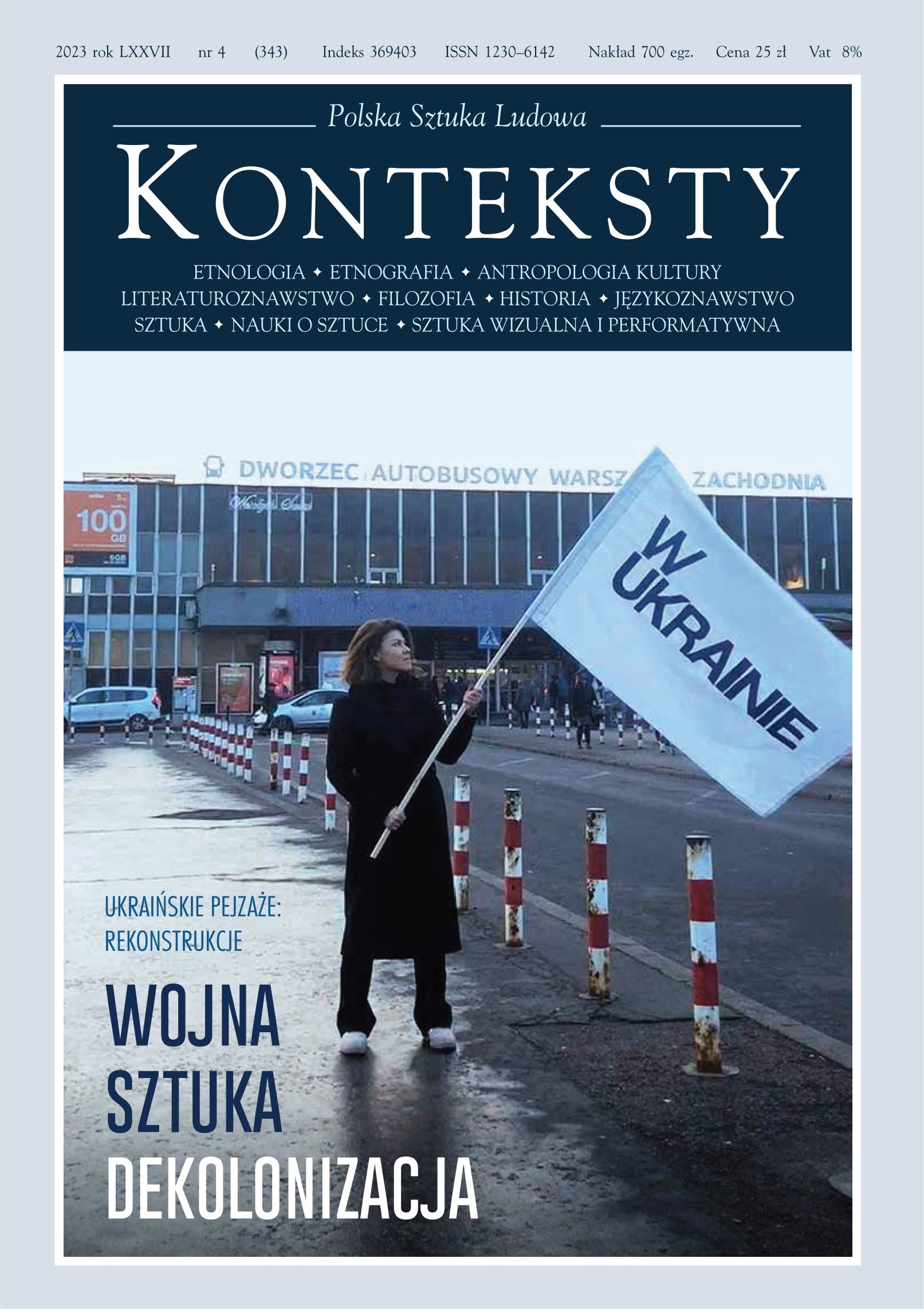The Romantic Poetics of “Irish Melodies” by Thomas Moore
Mirosława Modrzewska
miroslawa.modrzewska@ug.edu.plUniwersity of Gdańsk (Poland)
https://orcid.org/0000-0001-6460-0601
Abstract
Thomas Moore, composer and poet, published his Irish Melodies in ten subsequent volumes (1807–1834) as lyrical poems with musical accompaniment. In the first decades of the nineteenth century, songs sung solo and with the accompaniment of individual instruments became a new, emancipated way of artistic expression. In Moore’s time, it was a new medium, extremely desirable due to its capacity of reconciling authentic lyrical expression and mass distribution of texts. On the one hand, a new reader/listener of such works could represent a national or ethnic group heading for political emancipation, and, on the other hand, the performer or the addressee could be an individual personality seeking emotional identification with native legends and local history. Moore's song was part of the cultural trend of the democratization and politicization of literature in the era of revolution and liberation movements. According to the philosophy of Romanticism, music was a language of spirit and a voice of feelings, so the performative combination of poetry and music provided an opportunity to express meanings about personal and autobiographical experiences, and at the same time the experiences of a community, which could be symbolic and transcendental.
In Moore’s Irish lyrics, as in the works of many other poets and philosophers of the time, there occur a characteristic sacralization and mythologization of art as an attribute of “Old Erin”, the legendary but lost land of harpers, which was old Ireland. Its tragic story in Moore’s poetry also refers to the history of Europe and America, as the history of the struggle for freedom. His songs, as pieces that could be performed in any space and for any type and size of audience, were an ideal means of expression and a vehicle for national iconography in the political culture of the time.
Keywords:
Thomas Moore, romantic song, legendary country of harpers, romantic Irish iconography, romantic cultural mediaReferences
Boydell, Barra. “The Female Harp: The Irish Harp in 18th- and Early-19th-Century Romantic Nationalism.” RIdIM/ Research Center for Music Iconography Newsletter 20, no. 1 (Spring 1995):10-17.
Google Scholar
Cassirer, Ernst. The Myth of the State. New Haven and London: Yale University Press, 1974.
Google Scholar
Chinnéide, Veronica ní. “The Sources of Moore’s Melodies.” The Journal of the Royal Society of Antiquaries of Ireland 89, no. 2 (1959):109-134.
Google Scholar
Hurrell, Nancy. „Egan’s Irish Harps.” Irish Arts Review 36, no 3 (Autumn 2019):130-133.
Google Scholar
“Eriu”, IRISH STUDIES. Website of the Irish Studies Group at SUNY Geneseo (https://irishstudies.sunygeneseoenglish.org/eriu-mebd/, Accessed: 31.07.2024)
Google Scholar
Lessenich, Rolf P. Romantic Disillusionism and the Sceptical Tradition. Bonn: Bonn University Press, 2017.
DOI: https://doi.org/10.14220/9783737006323
Google Scholar
Love, Timothy M. “Gender and the Nationalistic Ballad: Thomas Davis, Thomas Moore, and Their Songs.” New Hibernia Review/ Iris Éireannach Nua 21, no. 1 (Spring 2017): 68-85.
DOI: https://doi.org/10.1353/nhr.2017.0005
Google Scholar
Modrzewska, Mirosława. „Robert Burns w kulturze globalnej. Perspektywa polska.” In Nowe oblicza romantyzmu brytyjskiego. Eseje na dwóchsetlecie, edited by Małgorzata Łuczyńska-Hołdys i Monika Coghen, 247-267. Warszawa: Wydawnictwo Uniwersytetu Warszawskiego, 2022.
DOI: https://doi.org/10.31338/uw.9788323555346.pp.247-268
Google Scholar
Moore, Thomas. Moore's Irish Melodies, With Symphonies and Accompaniments by Sir John Stevenson; and Characteristic Words by Thomas Moore. London [Boston, New York 1852]: Legare Street Press, 2021.
Google Scholar
Piechota, Marek. „Pieśń.” In Słownik literatury polskiej XIX wieku, edited by Józef Bachórz and Alina Kowalczykowa, 692-696. Wrocław, Warszawa, Kraków: Ossolineum, 1994.
Google Scholar
Pointner, Frank Erik i Dennis Weißenfels. „Thomas Moore, Irish Melodies (1808-1834)” In Handbook of British Romanticism, edited by Ralf Haekel, 474-488. Berlin/Boston: Walter de Gruyter GmbH, 2017.
DOI: https://doi.org/10.1515/9783110376692-027
Google Scholar
Rajnfandt, Christoph. “Popular and media Culture.” In Handbook of British Romanticism, edited by Ralf Haekel, 116-134. Berlin/Boston: Walter de Gruyter GmbH, 2017.
DOI: https://doi.org/10.1515/9783110376692-007
Google Scholar
Ritz, German. „Między «gender» a narodem – kobiety w polskim romantyzmie albo język płci.” Postscriptum 52, no. 2 (2006): 66-80. (https://bazhum.muzhp.pl/media/files/Postscriptum/Postscriptum-r2006-t-n2(52)/Postscriptum-r2006-t-n2(52)-s66-80/Postscriptum-r2006-t-n2(52)-s66-80.pdf, Accessed: 26.12.2022).
Google Scholar
Seldmayr, Gerold. „Political and Social history.” In Handbook of British Romanticism, edited by Ralf Haekel, 27-48. Berlin/Boston: Walter de Gruyter GmbH, 2017.
Google Scholar
Smith, Anthony D. Myths and Memories of the Nation. Oxford: Oxford University Press, 1999.
DOI: https://doi.org/10.1093/oso/9780198295341.001.0001
Google Scholar
“Thomas Moore’s Irish Melodies,” in Musica International. The Virtual Choral Library (https://www.musicanet.org/robokopp/moore.html, Accessed:12.11.2022)
Google Scholar
Tomaszewski, Mieczysław. „Muzyka i literatura.” In Słownik literatury polskiej XIX wieku, edited by Józef Bachórz and Alina Kowalczykowa, 579-588. Wrocław, Warszawa, Kraków: Ossolineum, 1994.
Google Scholar
White, Harry. “Moore, Thomas.” In Dictionary of Irish Biography (https://www.dib.ie/biography/moore-thomas-a5948, Accessed:12.11.2022)
Google Scholar
Authors
Mirosława Modrzewskamiroslawa.modrzewska@ug.edu.pl
Uniwersity of Gdańsk Poland
https://orcid.org/0000-0001-6460-0601
Mirosława Modrzewska – prof. UG. Jej zainteresowania badawcze koncentrują się wokół zagadnień literatury nowożytnej, zwłaszcza wieku XIX i romantycznej literatury angielskiej, polskiej i europejskiej. Jest współautorką poetyckiego tłumaczenia na język angielski poematu Juliusza Słowackiego Beniowski (Pieśni I–V) we współpracy z Peterem Cochranem (Poland’s Angry Romantic. Two Poems and a Play by Juliusz Słowacki (2009). Była współredaktorką wielojęzycznego wydania European Romanticism ze Stephenem Prickettem oraz redaktorką polsko-angielskiej części Polish Romanticism (2010). Jest członkinią International Association of Byron Societies i Gesellschaft für Englische Romantik. W latach 2014–2023 była założycielką i prezeską Polskiego Towarzystwa Studiów nad Europejskim Romantyzmem. W latach 2016–2018 współorganizowała cykle spotkań seminaryjnych na UG z pisarzami Gdańska i Pomorza (ukazały się jako: Pośród nas: twórcy gdańscy i pomorscy: rozmowy niedokończone 2016, 2018, 2019. Najważniejsze książki: Byron and the Baroque (2013) i Byron: Reality, Fiction and Madness (współredakcja z Marią Fengler) (2020).
Statistics
Abstract views: 152PDF downloads: 64
License
Copyright (c) 2025 Mirosława Modrzewska

This work is licensed under a Creative Commons Attribution 4.0 International License.







